How is the risk of injury to a person assessed by the current of an electrical installation in electrical networks with different configurations?
Knowledge of the processes taking place in electrical installations allows power engineers to safely operate equipment with any voltage and type of current, to carry out repair work and maintenance of electrical systems.
In order to avoid cases of electric shock to an electrical installation, the information contained in PUE, PTB and PTE — the main documents created by the best specialists based on the analysis of accidents with people injured by dangerous factors accompanying the operation of electrical energy.
Circumstances and reasons for exposing a person to electric current
The safety guidance documents distinguish three groups of causes explaining the electrocution of workers:
1. intentional, unintentional approach to live parts with voltage at a distance less than safe or touching them;
2. emergence and development of emergency situations;
3.violation of the requirements specified in the manuals prescribing the rules of behavior of workers in existing electrical installations.
The assessment of the danger of injury to a person consists in determining by calculations the magnitudes of the currents that pass through the victim's body. At the same time, many situations must be taken into account when contacts can occur at random places on an electrical installation. In addition, the voltage applied to them varies depending on many reasons, including the conditions and modes of operation of the electrical circuit, its energy characteristics.
Conditions for injury to persons from electric current
In order for current to flow through the victim's body, it is necessary to create an electrical circuit by connecting at least two points of the circuit that have a potential difference - voltage. The following conditions may occur with electrical equipment:
1. Simultaneous two-phase or two-pole touching of different poles (phases);
2. single-phase or single-pole contact with the circuit potential, when a person has a direct galvanic connection with the earth potential;
3. accidentally creating contact with conductive elements of the electrical installation that were under voltage as a result of the development of the accident;
4. falling under the action of the step voltage, when a potential difference is created between the points on which the legs or other parts of the body are located at the same time.
In this case, electrical contact of the victim with the current-carrying part of the electrical installation may occur, which is considered by the PUE as touching:
1. directly;
2. or indirectly.
In the first case, it is created by direct contact with a live part connected under voltage, and in the second, by touching non-insulated elements of the circuit when a dangerous potential has passed through them in the event of an accident.
In order to determine the conditions for safe operation of an electrical installation and to prepare a workplace for workers in it, it is necessary:
1. to analyze the cases of possible creation of paths for the passage of electric current through the body of the service personnel;
2. compares its maximum possible value with the current minimum permissible standards;
3. makes a decision to implement measures to ensure electrical safety.
Characteristics of the analysis of the conditions of injury to people in electrical installations
To estimate the magnitude of the current passing through the victim's body in a network with DC or AC voltage, the following types of designations are used for:
1. resistances:
-
Rh — in the human body;
-
R0 — for grounding device;
Ris — insulating layer relative to the contour of the earth;
2. currents:
Ih — through the human body;
Iz — short circuit to the earth loop;
3. stresses;
Uc — circuits with constant or single-phase alternating currents;
Ul — linear;
Uf — phase;
Upr — touches;
Ear - steps.
In this case, the following typical schemes for connecting the victim to the voltage circuits in the networks are possible:
1. direct current at:
-
single-pole contact of a wire contact with a potential isolated from the earth circuit;
-
unipolar contact of the circuit potential with a grounded pole;
-
bipolar contact;
2. three-phase networks at;
-
single-phase contact with one of the potential conductors (generalized case);
-
two-phase contact.
Fault circuits in DC circuits
Single-pole human contact with potential isolated from earth
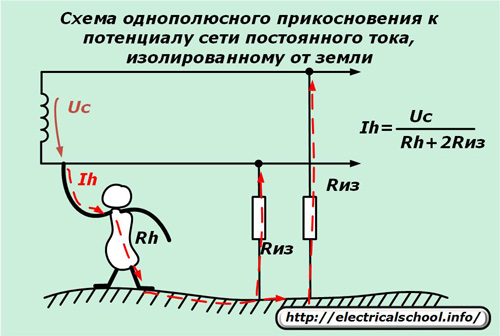
Under the influence of the voltage Uc, a current Ih passes through the doubled insulation resistance of the medium through the sequentially created circuit of the potential of the lower conductor, the victim's body (arm-leg) and the ground loop.
Single pole human contact with ground pole potential
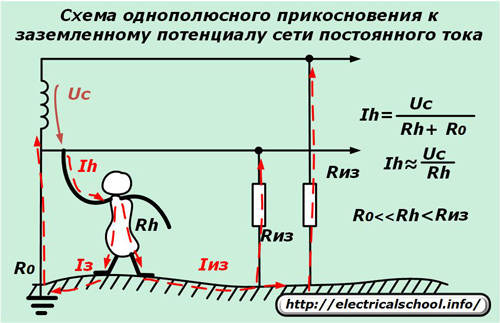
In this circuit, the situation is aggravated by connecting to the ground circuit a potential conductor with a resistance R0, close to zero and much lower than that of the victim's body and the insulating layer of the external environment.
The strength of the required current is approximately equal to the ratio of the mains voltage to the resistance of the human body.
Bipolar human contact with network potentials
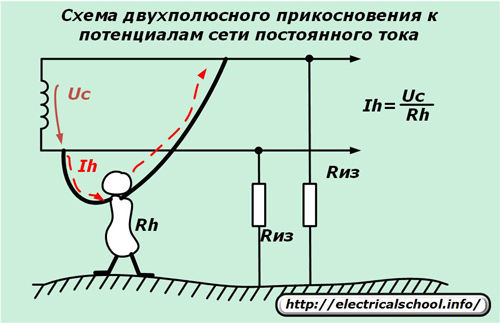
Mains voltage is applied directly to the victim's body, and the current through his body is limited only by his own negligible resistance.
General fault patterns in three-phase alternating current circuits
Establishing human contact between phase potential and ground
Basically there is a resistance between each phase of the circuit and a ground potential and capacitance is created. The zero of the windings of the voltage source has a generalized resistance Zn, the value of which varies in different grounding systems of the circuit.
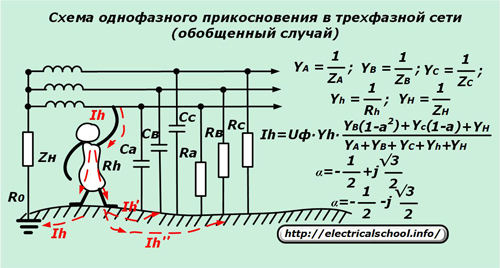
The formulas for calculating the conductivity of each circuit and the total value of the current Ih through the phase voltage Uf are shown in the picture by the formulas.
Formation of human contact between two phases
The greatest value and danger is the current passing through the circuit, created between the direct contacts of the victim's body with the phase conductors. In this case, part of the current can pass along the path through the ground and the insulation resistance of the medium.
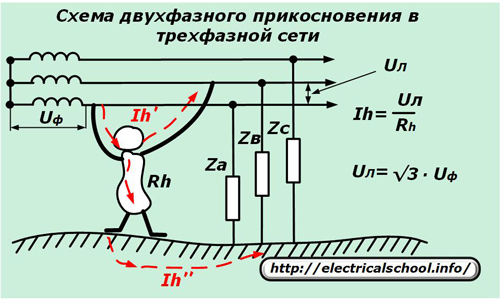
Characteristics of biphasic touch
In DC and three-phase AC circuits, making contacts between two different potentials is the most dangerous. With this scheme, a person falls under the influence of the greatest stress.
In a circuit with a constant voltage supply, the current through the victim is calculated by the formula Ih = Uc / Rh.
In a three-phase AC network, this value is calculated according to the ratio Ih = Ul / Rh =√3Uph / Rh.
Given that the average electrical resistance of the human body is 1 kilohm, we calculate the current that occurs in the network with a constant and alternating voltage of 220 volts.
In the first case it will be: Ih = 220/1000 = 0.22A. This value of 220 mA is sufficient for the victim to suffer a convulsive muscle contraction when, without assistance, he is no longer able to free himself from the effects of an accidental touch — the holding current.
In the second case Ih = (220·1.732)/1000= 0.38A. At this value of 380 mA, there is a fatal risk of injury.
We also pay attention to the fact that in a three-phase network with alternating voltage, the position of the neutral (it can be isolated from the ground or reverse-connected short circuit) has very little influence on the value of the current Ih . Its main share does not pass through the earth circuit, but between the phase potentials.
If a person has applied protective equipment that ensures his reliable isolation from the contour of the earth, then in such a situation they will be useless and will not help.
Characteristics of a single-phase tap
A three-phase network with a solidly grounded neutral
The victim touches one of the phase wires and falls under the potential difference between it and the ground circuit. Such cases occur most often.
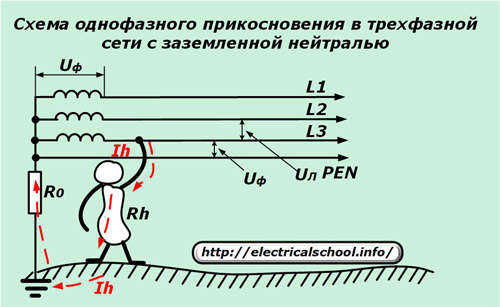
Although the phase-to-earth voltage is 1.732 times less than the mains voltage, such a case remains dangerous. The victim's condition may worsen:
-
neutral mode and its connection quality;
-
electrical resistance of the dielectric layer of the conductors relative to the ground potential;
-
type of shoes and their dielectric properties;
-
soil resistance at the site of the victim;
-
other related factors.
The value of the current Ih in this case can be determined from the ratio:
Ih = Uph / (Rh + Rb + Rp + R0).
Recall that the resistances of the human body Rh, the shoes Rb, the floor Rp and the ground at neutral R0 are taken in ohms.
The smaller the denominator, the stronger the current. If, for example, an employee wears conductive shoes, his feet are wet or his feet are lined with metal nails, and he is also on a metal floor or wet soil, then we can assume that Rb = Rp = 0. This guarantees the worst case for life of the victim.
Ih = Uph / (Rh + R0).
With a phase voltage of 220 volts, we get Ih = 220/1000 = 0.22 A. Or a lethal current of 220 mA.
Now let's calculate the option when the worker uses protective equipment: dielectric shoes (Rp = 45 kOhm) and insulating base (Rp = 100 kOhm).
Ih = 220/(1000+ 45000 + 10000) = 0.0015 A.
It obtained a safe current value of 1.5 mA.
Three-phase network with isolated neutral
There is no direct galvanic connection of the neutral of the current source to ground potential. The phase voltage is applied to the resistance of the insulating layer Rot, which has a very high value, which is controlled during operation and is constantly maintained in good condition.
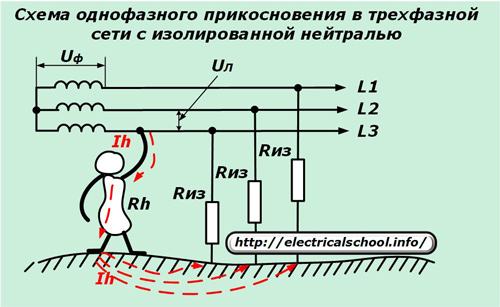
The chain of current flow through the human body depends on this value in each of the phases.If we take into account all layers of current resistance, then its value can be calculated by the formula: Ih = Uph / (Rh + Rb + Rp + (Riz / 3)).
In the worst case, when conditions are created for maximum conductivity through the shoes and the floor, the expression will take the form: Ih = Uph / (Rh + (Rf / 3)).
If we consider a 220-volt network with a layer insulation of 90 kΩ, we get: Ih = 220 / (1000+ (90000/3)) = 0.007 A. Such a current of 7 mA will feel good, but it cannot cause a fatal injury .
Note that we have intentionally omitted soil and shoe resistance in this example. If we take them into account, the current will decrease to a safe value, on the order of 0.0012 A or 1.2 mA.
Conclusions:
1. In systems with an isolated neutral mode, it is easier to ensure the safety of workers. This directly depends on the quality of the dielectric layer of the wires;
2. Under the same circumstances, touching the potential of one phase, a circuit with a grounded neutral is more dangerous than an isolated one.
Emergency mode of a single-phase contact in a three-phase network with a grounded neutral
Let's consider the case of touching the metal body of an electrical device, if the insulation of the dielectric layer at the phase potential is broken inside it. When a person touches this body, current will flow through their body to ground and then through the neutral to a voltage source.
The equivalent circuit is shown in the picture below. The resistance Rn is owned by the load created by the device.
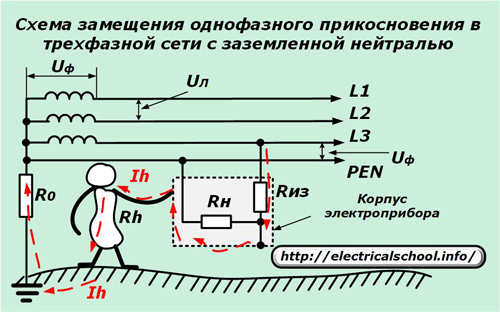
The insulation resistance Rot together with R0 and Rh limits the contact current between phases. It is expressed by the ratio: Ih = Uph / (Rh + Rot + Ro).
In this case, as a rule, even at the design stage, choosing materials for the case when R0 = 0, they try to comply with the condition: Rf>(Uph /Ihg)- Rh.
The value of Ihg is called the threshold of imperceptible current, the value of which a person will not feel.
We conclude: the resistance of the dielectric layer of all live parts to the ground contour determines the degree of safety of the electrical installation.
For this reason, all such resistances are normalized and reported from the approved tables. For the same purpose, not the insulation resistances themselves are normalized, but the leakage currents that pass through them during the tests.
Step voltage
In electrical installations, for various reasons, an accident can occur when the phase potential directly touches the ground loop. If on an overhead power line one of the conductors breaks under the influence of various types of mechanical loads, then in this case a similar situation occurs.
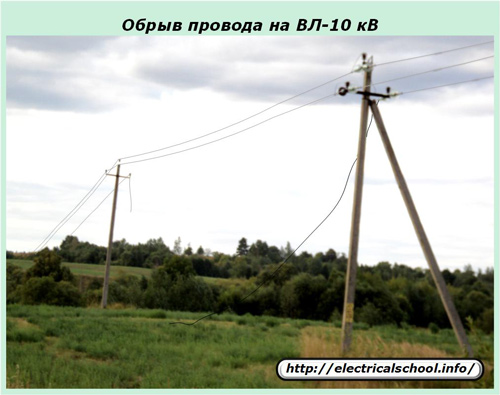
In this case, a current is generated at the point of contact of the conductor with the ground, which creates a diffusion zone around the point of contact - an area on the surface of which an electric potential appears. Its value depends on the closing current Ic and the specific soil condition r.
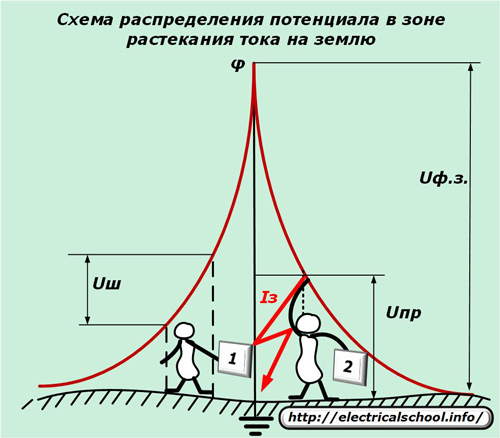
A person who falls within the limits of this zone falls under the influence of the tension of the Ush foot, as shown in the left half of the picture. The area of the diffusion zone is bounded by the contour where there is no potential.
The step voltage value is calculated by the formula: Ush = Uz ∙ β1 ∙ β2.
It takes into account the phase voltage at the point of current distribution — Uz, which is determined by the coefficients of the voltage distribution characteristics β1 and the influence of the resistances of shoes and legs β2. The values of β1 and β2 are published in reference books.
The value of the current through the victim's body is calculated using the expression: Ih =(U3 ∙ β1 ∙ β2)/Rh.
On the right side of the figure, in position 2, the victim makes contact with the ground potential of the conductor. It is influenced by the potential difference between the hand contact point and the ground contour, which is expressed by the touch voltage Upr.
In this situation, the current is calculated using the expression: Ih = (Uph.z. ∙α)/Rh
The values of the dispersion coefficient α can vary within 0 ÷ 1 and take into account the characteristics that affect Upr.
In the situation under consideration, the same conclusions apply as when making single-phase contact with the victim during normal operation of the electrical installation.
If a person is outside the current dispersal zone, they are in a safe zone.
